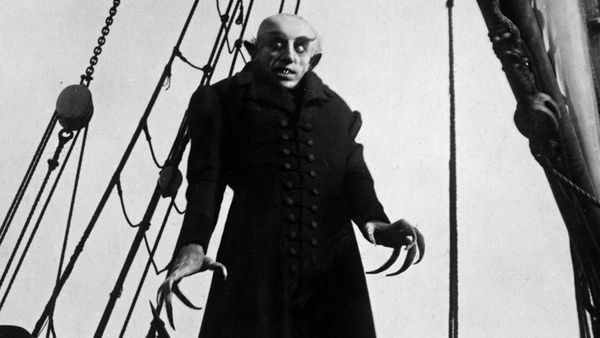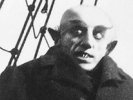Eye For Film >> Movies >> Nosferatu (1922) DVD Review

The Language Of Shadows is a full length documentary on the life and work (apropos The Vampire Movie) of F W Murnau, without a single mention of his sexual orientation, which is surprising because of the critical analysis of Nosferatu’s erotic content. You have to be an expert in the silent films of the Twenties to get the drift. Expressionist acting by Greta Schroeder, Gustav von Wangenheim and Alexander Granach, who plays the Renfield character, is too camp even for panto. Only Max Schreck, as Count Orlok (Dracula), who isn’t introduced in any depth, remains a mystery.
The documentary is deadly serious – no jokes – and is concerned as much with location as biography. Friedrich’s father was a textile manufacturer in Bielefeld and his mother came from a famous brewing family, which meant they weren’t exactly shot of a bob or two. Their name was Plumpe, which Murnau changed as soon as was humanly possible. He chose Murnau after an artists’ colony, south of Munich.

He had two brothers and a sister and he was the artistic one, putting on plays in his puppet theatre, with dreams of becoming an actor, about which his father would not hear a word. Their relationship was stormy and difficult, which is why he needed the support and love of his talented mother.
After leaving home, he went to Berlin and became involved with the avant-garde and expressionist movements. Max Reinhardt offered him a place in his theatre school as an actor and assistant director. During the First World War he was sent to Lithuania, where “he lay in the trenches for eight months” and contracted a kidney disease, which meant no more ciggies and booze - ever. By the end of the war he was flying reconnaissance planes and a year later made his first film, followed in the next 12 months by six more, none of which have survived.
Nosferatu was so low budget, Murnau could not afford sets, which is why so much was shot on location. For aficionados of the film this documentary will be especially interesting because it takes you to these locations as they are now.
The commentary track by film historian R Dixon Smith and film critic Brad Stevens is exactly what you might expect – and then more. Knowledgeable, encyclopedic almost, they compliment each other well and even if a debate about whether Nosferatu is an expressionist film, or a romantic one, goes on a bit there are loads of titbitish trivia pieces to assuage your appetite.
Because they had no money the filmmakers could not buy the rights to Bram Stoker’s Dracula and so they went ahead anyway, changing the names, hoping that no one would notice. Florence Stoker, Bram’s widow, noticed. She took them to court and won. All prints of the film had to be destroyed, but luckily one or two bootleg versions survived, from which this superior restoration has been made.
The Transylvania exteriors, which include Orlok’s castle, were shot in the Tatra mountains, Czechoslovakia, and these are pretty much exactly as they were in 1921. The character of Hutter (Jonathan Harker), as played by Gustov von Wangenheim, is examined closely for his emotional naivety, resulting in a further debate about whether his marriage was consummated – consensus says no – and therefore his wife Ellen’s (Mina) involvement with Orlok was sexual !??!
“He has the palpable stench of decay about him,” Stevens says. “Look at his hands. They are not hands. They are claws.”
Hardly George Clooney.
This is an admirable commentary that does credit to the history of a film that should have been lost forever and to a director, whose influence remains strong, even in the age of computer generated horror.
Reviewed on: 21 Nov 2007

















